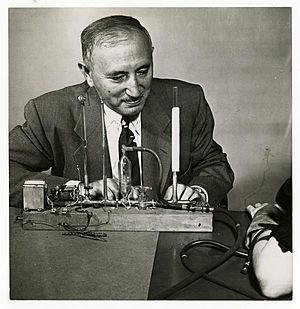David Wechsler facts for kids
Quick facts for kids
David "Wechy" Wechsler
|
|
|---|---|

Wechsler seated at a table, conducting a test on a patient.
|
|
| Born | January 12, 1896 Lespezi, Romania
|
| Died | May 2, 1981 (aged 85) New York City, U.S.
|
| Known for | Wechsler Adult Intelligence Scale, Wechsler Intelligence Scale for Children |
| Scientific career | |
| Fields | Psychology |
| Influences | Charles Spearman |
| Influenced | Alan S. Kaufman |
David Wechsler (born January 12, 1896 – died May 2, 1981) was an important psychologist from Romania and America. He is famous for creating special tests that measure intelligence. These tests include the Wechsler Adult Intelligence Scale (WAIS) and the Wechsler Intelligence Scale for Children (WISC). Many people still use his tests today to understand how people think and learn. In 2002, a study showed he was one of the most mentioned psychologists of the 20th century.
Contents
David Wechsler's Life Story
David Wechsler was born into a Jewish family in Lespezi, Romania. When he was a child, his family moved to the United States. He went to college at the City College of New York. Later, he earned his master's degree in 1917 and his Ph.D. in 1925 from Columbia University.
During World War I, Wechsler worked with the United States Army. He helped create psychological tests to check new soldiers. He also learned from famous thinkers like Charles Spearman. After working in different places, Wechsler became the chief psychologist at Bellevue Psychiatric Hospital in 1932. He stayed there until 1967. David Wechsler passed away on May 2, 1981.
Creating Smarter Intelligence Tests
Wechsler is best known for his intelligence tests. He believed that more than just "book smarts" are part of being intelligent. He thought that other things, like how you act and deal with problems, are also important.
Why Wechsler Created New Tests
In 1937, the main intelligence test was the Binet scale. Wechsler did not like that it only gave one score. He felt it did not fully show a person's intelligence. He wanted to create tests that looked at different parts of intelligence.
His first test, the Wechsler-Bellevue Intelligence Test, came out in 1939. This test later became the Wechsler Adult Intelligence Scale (WAIS). From this, he created the Wechsler Intelligence Scale for Children (WISC) in 1949. He also made the Wechsler Preschool and Primary Scale of Intelligence (WPPSI) in 1967.
Wechsler first made these tests to help understand his patients at the Bellevue clinic. He believed that intelligence means "the ability to act with a purpose, to think clearly, and to deal well with your surroundings."
What Makes His Tests Different?
Wechsler's tests brought new ideas to intelligence testing.
- No More "IQ" Scores: Older tests used a "quotient" score. Wechsler changed this. He set the average intelligence at 100 points. Then, he added or subtracted 15 points for how far above or below average someone scored.
- Two Main Areas: While he believed in a general intelligence, he divided it into two main parts:
- Verbal Scale: This part measures skills like understanding words, using language, and general knowledge.
- Performance Scale: This part measures non-verbal skills. This includes things like solving puzzles, understanding pictures, and working with shapes. Each part has different smaller tests.
See also
 In Spanish: David Wechsler para niños
In Spanish: David Wechsler para niños

